We feed cucumbers in the greenhouse for a rich harvest: diagrams and recipes
If a farmer is interested in a bountiful harvest when growing cucumbers, he cannot do without fertilizing. The cucumber bush has a weak and shallow root system that cannot keep up with the high rate of shoot growth and fruit ripening. At the same time, the wrong choice of fertilizers or violation of their application technique can aggravate the situation, cause an imbalance of nutrients in the soil and have a detrimental effect on the harvest.
Do I need to feed cucumbers in a greenhouse?
Greenhouse growing of cucumbers has its own nuances. On the one hand, favorable temperature conditions are created under the film or glass, on the other hand, a closed space often causes excessive humidity and lack of air.
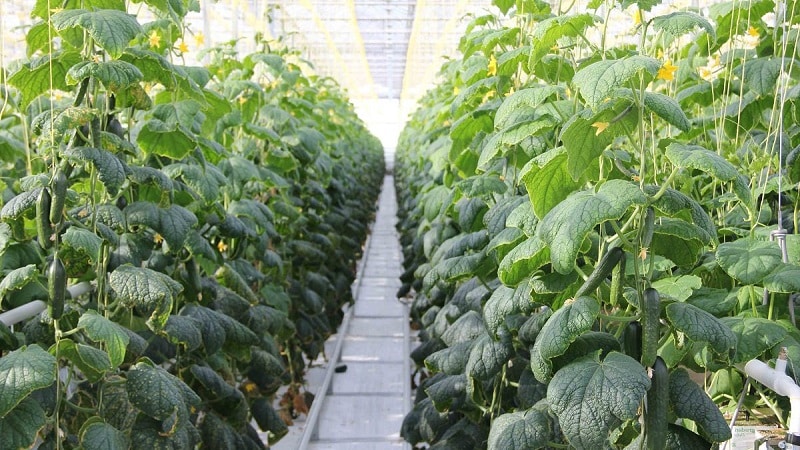
Unlike open ground, In greenhouse conditions it is more difficult to maintain crop rotation, which leads to gradual depletion and acidification of the soil. This can be avoided by taking care of preparing the soil mixture in advance.
In addition, often in greenhouses the planting is denserthan in open beds, and the plants themselves develop faster and more intensively. Consequently, cucumbers need more frequent feeding.
Reference! If in open ground conditions 2-3 fertilizing per season is enough for cucumbers, in greenhouses they need to be fertilized at least 4 times.
What is the effect of fertilizing in August?
Usually, August coincides with the stage of intensive fruiting of cucumbers. At this time, the whip may weaken due to the distribution of nutrients within the plant, the need for potassium and other micro- and macroelements increases. Timely feeding will help bring the vegetable back to life and extend its growing season.
How to determine what a plant is missing
Cucumbers are sensitive to a lack or excessive amount of certain nutrients; they quickly react to an imbalance by stopping the growth and development of the plant, deforming the fruit, and reducing taste.
Any of these manifestations is a signal of improper nutrition of the plant.
Potassium
About the fact that cucumbers lack potassium, the following signs say:
- too active growth of tops (lashes and leaves) against the background of the absence or crushing of fruits;
- change in leaf color to dark green;
- a light border on the lower leaves with a pronounced burn - yellow spots on the shoots;
- the fruits take on the shape of a pear - they taper near the stalk.
Besides, potassium is responsible for plant immunity, therefore, if there is a shortage of it, it becomes defenseless against various types of infections.
Will help replenish lost substances an aqueous solution of potassium sulfate or wood ash.
Reference! A common cause of potassium starvation in cucumbers at the flowering and fruiting stage is excessive application of nitrogen fertilizers at the beginning of the season.
Nitrogen
Nitrogen serves as a component of proteins, and they, in turn, participate in the formation of the nucleus and cytoplasm of cells. Therefore, if there is insufficient nitrogen content in the soil:
- the fruits acquire a light green color and a “beak-like” shape: the tip (of the flower) becomes narrow and sharp;
- the lower leaves turn yellow;
- the growth of side shoots slows down;
- the lashes become thin and hard, quickly become woody;
- The ovaries crumble and some of the flowers die.
Reference! Insufficient watering of the plant prevents the normal absorption of nitrogen from the soil.
To “reanimate” plantings, they can be fertilized with an aqueous solution of urea or ammonium sulfate. Nitrogen is also found in manure, peat and compost.
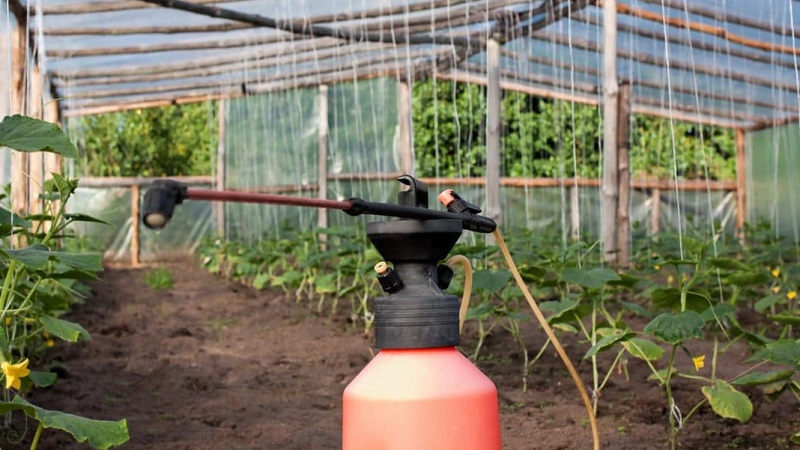
Magnesium
With magnesium deficiency there are:
- light green spots on the leaves,
- the leaves then turn yellow and fall off;
- multi-colored spots between the veins: yellow, red and purple;
- slow plant growth.
Reference! Excess potassium in the soil can lead to magnesium deficiency.
Calcium
Calcium participates in the formation of plant cell walls and membranes. Therefore, if there is a deficiency:
- light yellow spots appear on young leaves;
- the leaves themselves become smaller and curved, and a “fringe” appears along the edges;
- a purple color appears on the underside of the leaf;
- the growth of the bush slows down due to the rapid aging of the root system;
- the fruits grow small and rough, and their taste deteriorates.
Calcium present in wood ash, therefore fertilizer based on it is one of the most effective for cucumbers.
Bora
A trace element such as boron consumed by plants in small quantities. However, its lack has negative consequences:
- cucumber vines grow more slowly;
- the apical point of the shoot dies;
- flowers and ovaries fall off.
All this interferes with the normal fruiting of the plant.
Attention! To compensate for the lack of boron, foliar feeding is necessary. When carrying out this, it is important to remember that boric acid does not dissolve in cold water, so the substance is diluted in hot water (about 50 ° C), then cooled to room temperature and diluted to the desired concentration again.
Phosphorus
Cucumbers have a special need for phosphorus during the period when inflorescences appear., but it is also important for the development of the root system. If plants lack a microelement, then:
- the growth of lateral branches and leaves will slow down;
- the leaves “shrink”: new ones grow much smaller in size than the old ones;
- new leaves will appear darker in color;
- the shoots will quickly wither and crumble.
Solutions of ammophos and diammophos will eliminate phosphorus deficiency, as well as an aqueous solution of superphosphate.
Reference! Although plants need a trace element in small quantities, it is important to ensure that it is supplied constantly.
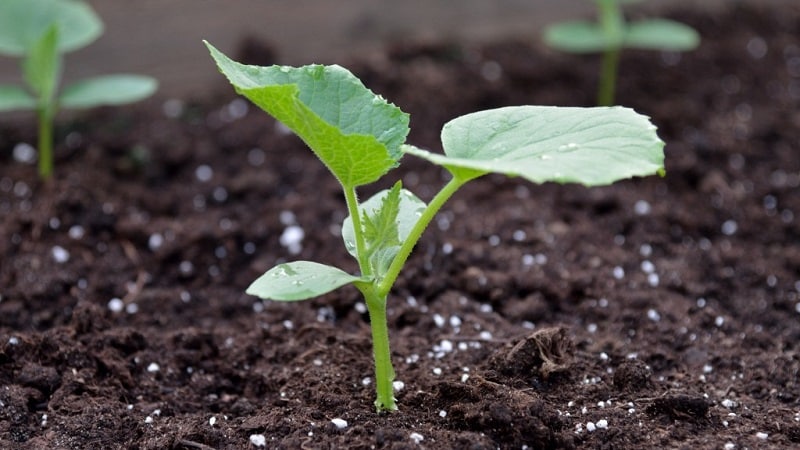
Molybdenum
If the plant lacks molybdenum, this will become noticeable by such signs as:
- leaf chlorosis, pale veins;
- curved edges;
- small flowers.
Reference! An excess of ammonia nitrogen and heavy metals in the soil leads to a lack of molybdenum.
Gland
Iron participates in the production of chlorophyll, so if there is a lack of it:
- the plant slows down;
- the leaves become lighter, their color can vary from light yellow to lemon and almost white;
- growth points do not develop.
Reference! The problems described do not always indicate iron deficiency. The issue may be poor absorption of the substance due to a lack of potassium, or, conversely, an excess of phosphorus, calcium, copper or zinc.
Copper, zinc and manganese
Manganese plays a special role in plant respiration, as it promotes more efficient absorption of carbon dioxide by green mass. With a lack of this microelement, light (so-called “chlorotic”) spots appear on young leaves, then acquire a brown or yellow tint.
Zinc deficiency also especially noticeable on young shoots. Leaves and petioles turn brown and then die.
From a lack of copper The tips of the leaves turn pale, the color changes to a specific blue-green, the edges of the shoots curl into a tube. Flowers may fall off.
How to feed cucumbers in a greenhouse
The right choice of fertilizers will help plants absorb the necessary substances more efficiently.
In general, fertilizers are classified into:
- organic (vermicompost, humus, peat, manure, bird droppings, ash, compost);
- mineral (simple and complex).
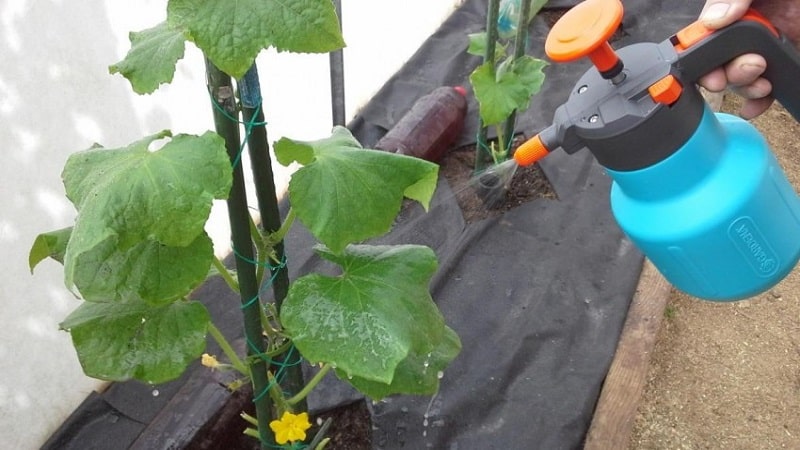
Organic fertilizers
Organic fertilizers are good because contain a complex of nutrients and often do not require costs to purchase: manure and poultry droppings are by-products of livestock farming, and compost heaps are available on almost any farm.
Nevertheless, “organic” also has disadvantages. First of all, due to its natural origin, one cannot be 100% sure of the composition of the fertilizer, the concentration of micro- and macroelements, since this depends on many factors. Secondly, organic fertilizers have a slower, “softer” action.
Most often used for feeding cucumbers:
- slurry,
- infusion of herbs (“herbal tea”),
- chicken droppings.
Mineral fertilizers
Mineral fertilizers characterized by faster and harsher action, therefore, a smaller volume of substance is required for fertilizing. The gardener can control the chemical composition of the soil, adding only those elements that are necessary to achieve optimal balance.
Mineral fertilizers can be one-component:
- ammonium nitrate (contains nitrogen);
- superphosphate (phosphorus);
- potassium chloride.
Complex fertilizers are used to feed several elements at once.:
- nitrophoska (phosphorus, nitrogen and potassium);
- ammophos (phosphorus and nitrogen), etc.
Folk remedies
Among the popular folk recipes for feeding cucumbers:
- yeast;
- wood ash;
- iodine;
- "herbal tea"
Yeast fertilization has a beneficial effect on growth and fruiting of the plant, however, you need to beware of recipes with added sugar, since in conditions of high humidity in greenhouses they can cause mold growth and the development of fungal diseases. A solution of yeast with ascorbic acid gives an excellent result: 10 g of dry yeast, 2 g of ascorbic acid and 5 liters of warm water.
Wood ash - one of the best fertilizers under conditions of excess nitrogen in the soil. It contains large quantities of calcium, potassium, phosphorus and a whole range of microelements (boron, iron, magnesium, manganese, molybdenum, sulfur, zinc, copper).
Use ash:
- in dry form, scattered in a thin layer around the bushes;
- as a solution (2 tablespoons of ash per 1 liter of water);
- in the form of a tincture for foliar feeding (proportion with water 1:5, that is, 1 tbsp. ash per 1 liter of water).
Iodine stimulates the growth of cucumbers, rejuvenates the vines and lengthens the fruiting period. It also helps fruits accumulate vitamin C. Use aqueous (30 drops per 10 liters of water) and water-milk solutions (30 drops per 1 liter of milk and 10 liters of water).
To prepare “herbal tea” take crushed weeds and pour water (10 liters per 1.5-2 kg of green mass), leave for a week to ferment. This product is especially effective for feeding fruit-bearing bushes, as it avoids feeding with chemical fertilizers.
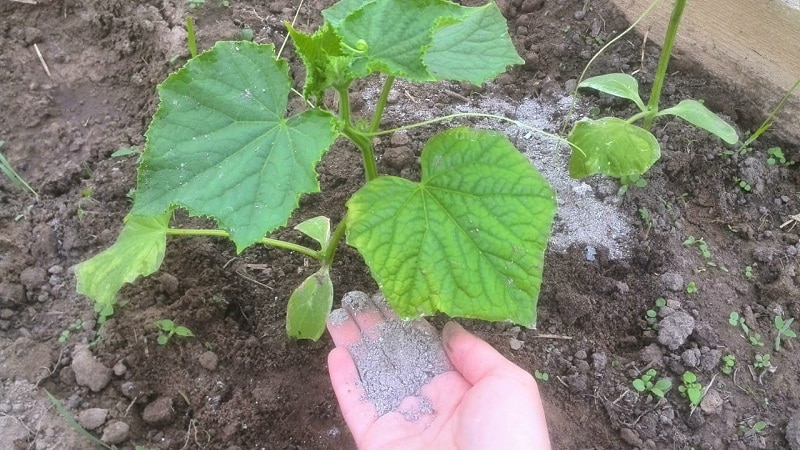
Types of fertilizing
Based on the method of applying fertilizers, a distinction is made between root and foliar feeding.
Root
Fertilizer application is combined with watering plants at the roots. The disadvantage of this method is that nutrients spread throughout the soil and can promote the growth of weeds.
Foliar
This is a fertilizer by spraying a nutrient solution on the leaves and stems. This type of feeding is considered more effective and desirable; it is often used for “emergency resuscitation” of weakened plants. The result can be noticeable within a few hours after the procedure.
It's important to follow the rules:
- avoid high concentrations of the substance;
- Fertilize in the evening or on a cloudy day to prevent leaf burn.
When and what kind of feeding is needed: schemes for feeding cucumbers in a greenhouse
More often offer the following feeding scheme for cucumbers:
- the first - 15-20 days after planting;
- the second - at the beginning of flowering;
- the third - during the fruiting period;
- the fourth - 10 days after the third, to extend the life of the cucumber vines and reap a richer harvest.
In addition, it is possible to apply special fertilizers in case of plant disease.
Feeding the soil
In autumn after harvest It is important to get rid of plant residues, disinfect all parts of the greenhouse structure and dig up the soil. At the same time, they prepare the soil for the next season by adding rotted manure, humus or compost. To reduce soil acidity, dolomite flour or fluffed lime (300-500 g per sq. m) is also used.
In spring, at least a week before planting cucumber seedlings, the soil is dug up again and fertilized with ammonium nitrate, potassium sulfate and superphosphate (in equal proportions). To disinfect the soil, water it with a weak solution of potassium permanganate (1-3 g per 10 liters of warm water).
After landing
For the development of shoots and leaves, cucumbers need in nitrogen fertilizers. Therefore, 2 weeks after planting the seedlings, nitrogen-containing mineral fertilizers (ammonium nitrate, nitrophoska) or organic matter (mullein, chicken droppings) are added to the soil. Conduct root feeding: 0.5-1 liters of nutrient solution per plant.
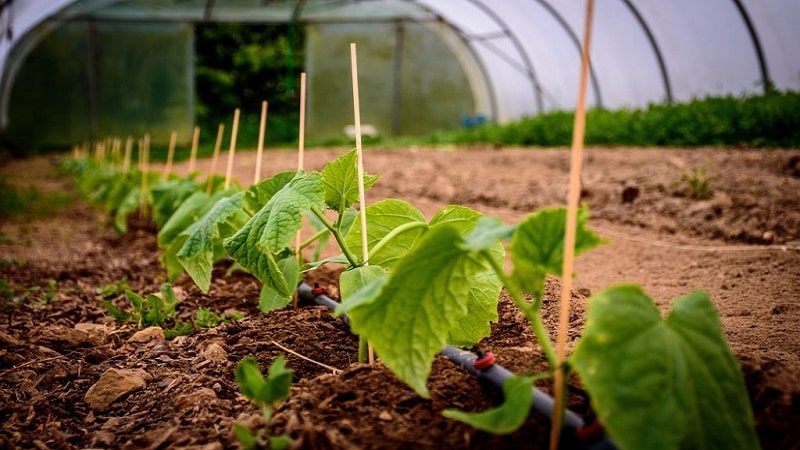
During the flowering period
During the flowering and fruit set phase, cucumbers need phosphorus.. Feeding with a “cocktail” gives good results:
- 0.5 liters of liquid mullein,
- 1 tbsp. l. nitrophoska,
- 1 glass of ash or 2 tbsp. l. potassium sulfate,
- 0.5 g boric acid,
- 0.3 g manganese sulfate,
- 10 liters of water.
If they grow poorly
Slow plant growth may be due to a lack of various elements, but most often - their imbalance.
During the fruiting stage, cucumbers are fed:
- ash, as it is rich in calcium and potassium. Sprinkle ash on the ground around the bushes or water the soil with a 10-day infusion (1 glass of ash per 5 liters of water);
- yeast (100 g per 10 liters of water);
- weak solution of manure (1:20).
From diseases
From root rot The harvest will be saved by applying fertilizers containing copper: copper sulfate or iodine (dissolved in water or milk).
With gray rot Baking soda copes: 75 g per 10 liters of water. The resulting solution is sprayed onto the bushes every 3-4 days.
Zelenka (brilliant green) is used for powdery mildew or peronosporosis. To do this, dissolve 50 g of urea, 2 l of whey and 10 ml of brilliant green in 10 liters of water. The lashes are sprayed with this solution 3 times with an interval of 10 days.
During fruiting
During the period of active fruit formation, cucumbers are fertilized with a mixture: 2 tbsp. l. potassium nitrate, 5 tbsp. l. urea and 1 glass of ash. All this is dissolved in 10 liters of water and the bushes are watered at the root.
In August to prolong fruiting
10 days after the third feeding, the plants are fertilized with an ash solution (1 glass of ash per 10 liters of water). It is rich in potassium and calcium.
In addition, spray with a urea solution (1 matchbox per 10 liters of water).
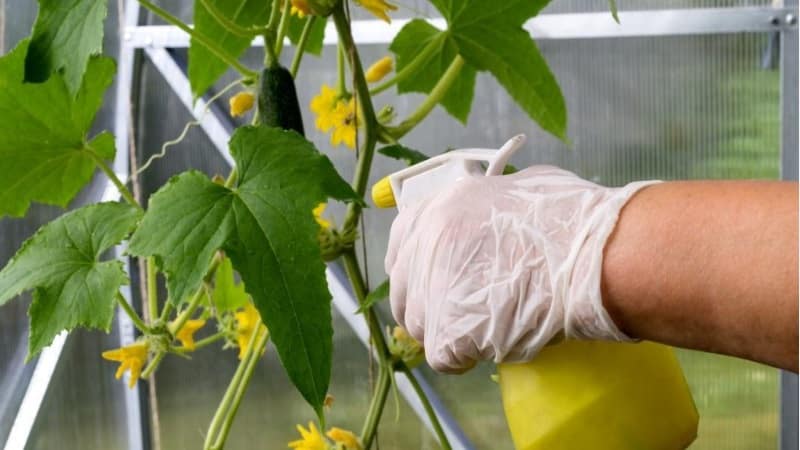
Do I need to feed in winter?
If cucumbers are grown in a winter greenhouseIn addition to maintaining temperature and artificial lighting, you should take care of fertilizing the soil. A good harvest requires fertile, loose soil. For example:
- 10 liters of semi-rotted sawdust;
- 20 liters of humus;
- 20 liters of peat;
- 300 g wood ash;
- 130 g nitroammophoska.
Next, a solution of cow manure is used as fertilizer. (in a ratio of 1:5 with water), ash (3:10) or nitroammophosphate (15:100).
What happens if there is too little or too much fertilizer?
The general rule for feeding cucumbers is:: Delicate crops respond better to a lack of fertilizer than to an excess. Therefore, you should avoid feeding plants too often and high concentrations of substances. Any root feeding should be combined with abundant watering, as water helps to better absorb micro- and macroelements and prevent burns.
Among the examples of “overfed” cucumbers:
- due to excess nitrogen, the vines become fattened: all the forces go into the thick stem and dark green leaves of the plant, and flowering slows down and ovaries do not form;
- too much phosphorus causes leaves to turn yellow;
- increased potassium content interferes with nitrogen absorption and slows down plant development;
- excess calcium provokes mosaic leaves;
- Excessive amounts of zinc appear as discolored areas between the veins on the leaves.
Conclusion
When feeding cucumber plantings, it is important to observe the measure and clearly understand what substances the plant needs in a given period. Therefore, a gardener should know the main signs of both deficiency and excess of the most important micro- and macroelements, as well as follow the recommended feeding schemes.